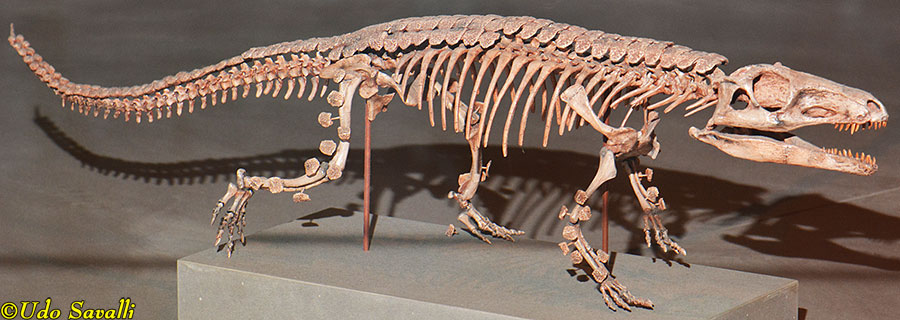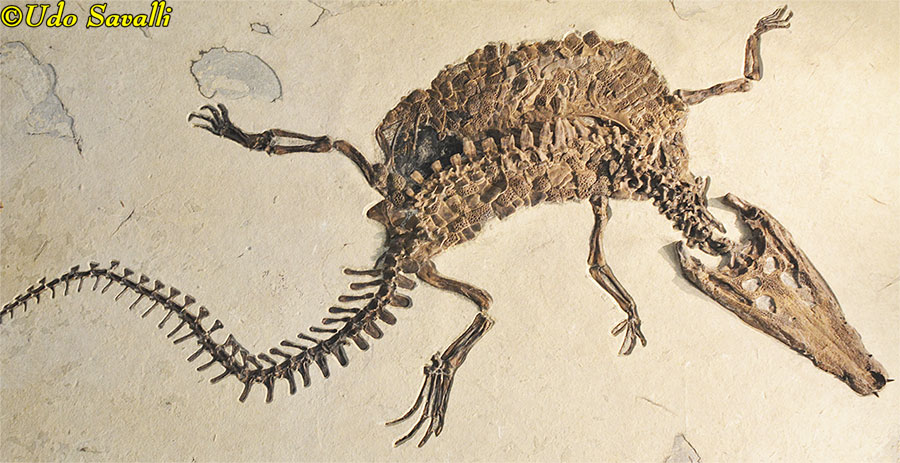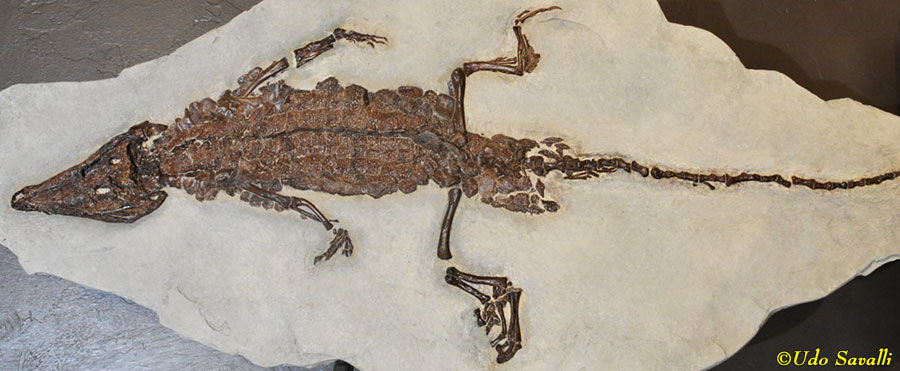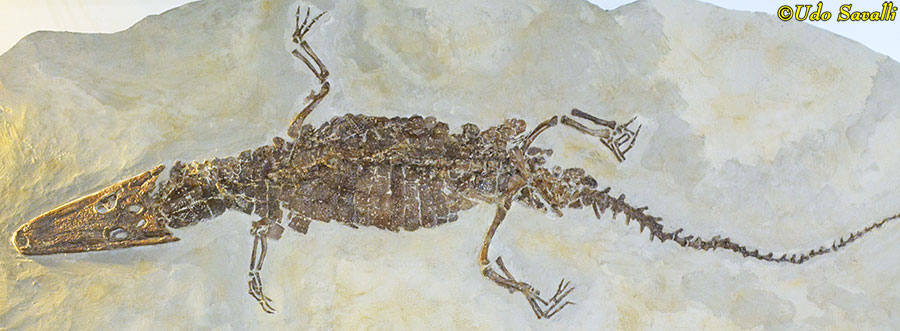Phytosauria
|
Pseudosuchia is the clade that includes all crocodile-line Archosaurs (archosaurs more closely related to crocodiles than to dinosaurs or birds).
The most basal group in the clade are the Phytosaurs (a misleading name meaning plant lizard since the first fossil found had damaged teeth was thought, incorrectly, to be an herbivore). Phytosaurs look remarkably like modern crocodylians, with elongated bodies, sprawling posture, laterally-flattened tail and long snouts, but they evolved these features independently as the crocodylians of the time were very different terrestrial animals.
This Redondosaurus sp. skeleton is a composite derived from bones of 6 individuals.
Taxonomy: Archosaura; Pseudosuchia; Phytosauria; Phytosauridae
Bull Canyon & Redonda Formations, Chinle Group, New Mexico
Late Triassic Period, 205 Ma
New Mexico Museum of Natural History & Science
|

|
|
|
Dorsal view of a Machaeroprosopus (formerly Pseudopalatus) sp. skull and mandible. The external nares (nostrils) are located on the forehead, which distinguishes phytosaurs from modern crocodylians which have their nostrils at the tip of the snout.
Taxonomy: Archosaura; Pseudosuchia; Phytosauria; Phytosauridae
Bull Canyon Formation, Chinle Group, Quay Co., New Mexico
Late Triassic Period
New Mexico Museum of Natural History & Science
|

|
|
|
The skulls of Machaeroprosopus show considerable variation even in a single locality (compare to example above). This may reflect several closely related species in the same area or could indicate sexual dimorphism.
Taxonomy: Archosaura; Pseudosuchia; Phytosauria; Phytosauridae
Bull Canyon Formation, Chinle Group, New Mexico
Late Triassic Period
New Mexico Museum of Natural History & Science
|

|
|
|
Phytosaurs, like modern crocodylians, were semi-aquatic ambush predators that ate a variety of vertebrate prey. This skull is from Leptosuchus crosbiensis.
Taxonomy: Archosaura; Pseudosuchia; Phytosauria; Phytosauridae
late Triassic Period
Arizona Museum of Natural History
|

|
|
|
Angistorhinus sp.
Taxonomy: Archosaura; Pseudosuchia; Phytosauria; Phytosauridae
Colorado City Formatiom, Chinle Group; New Mexico
Late Triassic Period
New Mexico Museum of Natural History & Science
|

|
|
Aetosauria
|
Aetosaurs were heavily armored herbivores with dorsal bony plates and in some cases, spines. They had small heads ending in an upturned snout.
This is Desmatosuchus haplocerus
Taxonomy: Archosaura; Pseudosuchia; Aetosauria; Stagonolepidae
Chinle Formation; Arizona
late Triassic Period
Petrified Forest National Park
|

|
|
|
Cast of a Desmatosuchus sp. skull
Taxonomy: Archosaura; Pseudosuchia; Aetosauria; Stagonolepidae
Texas
late Triassic Period
Field Museum, Chicago
|

|
|
|
A complete but somewhat distorted fossil (cast) of Typothorax coccinarum. The skull is at the right. The apparant hump is dorsal armor that would normally sit flat on the back. The front legs are pressed against the body and not as easily distinguishable.
Taxonomy: Archosaura; Pseudosuchia; Aetosauria; Stagonolepidae
Bull Canyon Formation, Chinle Group, Quay Co., New Mexico
Late Triassic Period, 220 Ma
New Mexico Museum of Natural History & Science
|

|
|
|
Revueltosaurus callenderi is a small (1 m long) ancestral relative of the aetosaurs. It had some dermal armor, but its extent and arrangement is not known.
Taxonomy: Archosaura; Pseudosuchia
Chinle Formation; Arizona
late Triassic Period
Petrified Forest National Park
|

|
|
|
These tracks have been named Brachychichirotherium. The actual maker of these tracks is unknown, but they probably belong to an Aetosaur.
Taxonomy: Archosaura; Pseudosuchia ; Aetosauria?
Moenave Formation, St. George, Utah
Early Jurassic Period
Dinosaur Discovery Site, Utah
|

|
|
Rauisuchians
|
Rauisuchia is a paraphyletic grouping of pseudosuchians between the Aetosaur and Crocodylomorph branches. They are mostly (with some exceptions) large-headed predators. Some were probably bipedal.
This reconstruction of Postosuchus kirkpatricki is out of date, as a recent study determined that the font legs were smaller (this reconstruction is based on a composite from multiple individuals) and thus it was likely bipedal.
Taxonomy: Archosaura; Pseudosuchia; Loricata; "Rauisuchia"; Rauisuchidae
Chinle Formation, Arizona
late Triassic Period, 228-202 Ma
Petrified Forest National Park
|

|
|
|
Life model of Postosuchus kirkpatricki
Taxonomy: Archosaura; Pseudosuchia; Loricata; "Rauisuchia"; Rauisuchidae
Late Triassic Period, 225 Ma; Arizona
Arizona Museum of Natural History
|

|
|
Crocodylomorpha
|
The Crocodylomorpha includes all living crocodylians as well as their extinct relatives that are closer to crocodiles than to Rauisuchians. The crocodylomorphs as a whole were morphologically much more diverse than the surviving modern species. The earliest forms were relatively small, terrestrial, and with long legs held beneath the body.
Life model of Protosuchus sp., a typical early, terrestrial crocodile ancestor.
Taxonomy: Archosaura; Pseudosuchia; Crocodylomorpha; Protosuchidae
Early Jurassic Period
Dinosaur Discovery Site, St. George, Utah
|

|
|
|
Life model of Fruitachampsa sp., another terrestrial crocodylomorph.
Taxonomy: Archosaura; Pseudosuchia; Crocodylomorpha; Shartegosuchidae
Late Jurassic Period, 149 Ma; Colorado
Arizona Museum of Natural History
|

|
|
|
Parringtonia gracilis skeleton cast. The exact relationship of this species with other pseudosuchians is uncertain, though a primitive member of the crocodylomorpha is possible.
Taxonomy: Archosaura; Pseudosuchia; Crocodylomorpha?; Erpetosuchidae†
Tanzania
Middle Triassic, 247-242 Ma
Field Museum, Chicago
|

|
|
|
There are a number of distinctive subgroups of crocodylomorphs. One such group is the Thalattosuchia, the marine crocodiles. Most thalattosuchians were fully aquatic, with flippers and a tail fluke, although the most basal members were semi-aquatic.
Macrospondylus bollensis (formerly in the genus Steneosaurus) was a primitive, semi-aquatic member of the Thalattosuchia
Taxonomy: Archosaura; Pseudosuchia; Crocodylomorpha; Thalattosuchia†; Teleosauroidea
Europe
Early Jurassic Period, 195 Ma
Wyoming Dinosaur Center
|

|
|
|
Another distinctive subgroup of crocodylomorphs is the Notosuchia (southern crocodiles), a group that was mostly restricted to the southern hemisphere. They were terrestrial, with an upright posture (legs held beneath body), and had diverse diets and lifestyles.
Fossil of Araripesuchus patagonicus, a dog-sized predatory notosuchian.
Taxonomy: Archosaura; Pseudosuchia; Crocodylomorpha; Notosuchia†; Uruguaysuchidae
South America
Cretaceous Period
Fernbank Museum of Natural History, Georgia
|

|
|
|
The Neosuchia is the sister group to the Notosuchia. Most neosuchians were large, semi-aquatic reptiles like their modern descendants, the crocodiles and alligators.
Sarcosuchus imperator was a giant basal neosuchian capable of eating dinosaurs, although it is less closely related to the modern crocodylians (the white skull is a modern crocodile for scale).
Taxonomy: Archosaura; Pseudosuchia; Crocodylomorpha; Neosuchia; Pholidosauridae†
Tegana Formation, Morocco
Cretaceous Period, Albian/Cenomanian Stage, 110-90 Ma
Black Hills Institute Museum, South Dakota
|

|
|
|
Terminonaris robusta had a long, slender snout used to capture fish, much like the modern gharials.
Taxonomy: Archosaura; Pseudosuchia; Crocodylomorpha; Crocodylia; Pholidosauridae
Carbon Co., Montana
Cretaceous Period, 93 Ma
Museum of the Rockies, Montana
|

|
|
|
Dyrosaurus sp.
Taxonomy: Archosaura; Pseudosuchia; Crocodylomorpha; Crocodylia; Dyrosauridae
Morocco
Eocene Epoch, 50 Ma
Wyoming Dinosaur Center
|

|
|
|
Amphicotylus sp. reconstructed skeleton. A 'stem-crocodylian,' that is, outside the crown group of all living crocodylians, but still closer to crocodiles than to more terrestrial ancestors.
Taxonomy: Archosaura; Pseudosuchia; Crocodylomorpha; Goniopholididae
Morrison Formation, Bone Cabin Quarry, WY
Late Jurassic Period
Tuscon Gem & Mineral Show
|

|
|
|
Goniopholis sp. is a semi-aquatic crocodylomorph that is near the base of the Neosuchia (the group that is more closely related to modern crocodiles than to the notosuchians).
Taxonomy: Archosaura; Pseudosuchia; Crocodylomorpha; Goniopholididae
North America, Eurasia
Late Jurassic to early Cretaceous Periods
Museum of Ancient Life, Utah
|

|
|
|
The Crocodylia proper refers to the crown group crocodylians, that is, the descendants of the most recent common ancestor of all extant crocodiles, alligators, and gavials. As a general rule, these are fairly large, semi-aquatic predators
Leidyosuchus sp. skull.
Taxonomy: Archosaura; Pseudosuchia; Crocodylomorpha; Crocodylia
Cloverly Formation, Montana
Late Cretaceous Period
Black Hills Institute Museum, South Dakota
|

|
|
|
Deinosuchus riograndensis (skull cast) was one of the largest crocodylians ever, and most likely ate dinosaurs. It may be related to modern alligators. (The small white skull is a modern crocodile skull for scale.)
Taxonomy: Archosaura; Pseudosuchia; Crocodylomorpha; Crocodylia?
Aguja Formation, Big Bend area, TX
Late Cretaceous Period, Campanian Stage, 84-69 Ma
Black Hills Institute Museum, South Dakota
|
 |
|
|
Borealosuchus wilsoni is a good example of a typical, modern, semi-aquatic crocodylian.
Taxonomy: Archosaura; Pseudosuchia; Crocodylomorpha; Crocodylia; Alligatoridae?
Fossil Lake, WY
Eocene Epoch
Museum of the Rockies, Montana
|

|
|
|
Borealosuchus sp. was a mid-sized crocodile reaching up to 3 m long.
Taxonomy: Archosaura; Pseudosuchia; Crocodylomorpha; Crocodylia; Alligatoridae?
McCone Co., Montana
Eocene Epoch
Museum of the Rockies, Montana
|

|
|
|
Another Borealosuchus sp. fossil
Taxonomy: Archosaura; Pseudosuchia; Crocodylomorpha; Crocodylia; Alligatoridae?
Green River Formation, Kemmerer, WY
Eocene Epoch
Tuscon Gem & Mineral Show
|

|
|
|
Life model of Pristichampsus sp., a true crocodile, but one that was nonetheless mostly terrestrial.
Taxonomy: Archosaura; Pseudosuchia; Crocodylomorpha; Pristichampsidae
Eocene Epoch
San Diego Natural History Museum
|

|
|
|
Diplocynodon sp was a mid-sized alligator ranging from 1-3 m.
Taxonomy: Archosaura; Pseudosuchia; Crocodylomorpha; Crocodylia; Alligatoridae
Gracanica, Bosnia
Middle Miocene Epoch, 16-14 Ma
Tuscon Gem & Mineral Show
|

|
|
This Tsoabichi greenriverensis caiman is a fairly small (<1m long) semi-aquatic predator related to the alligators.
Taxonomy: Archosaura; Pseudosuchia; Crocodylomorpha; Crocodylia; Alligatoridae
Green River Formation, Wyoming
Eocene Epoch
Black Hills Institute Museum, South Dakota
|

|
|
|
Stangerochampsa sp. is a small crocodylian related to alligators.
Taxonomy: Archosaura; Pseudosuchia; Crocodylomorpha; Crocodylia; Alligatoridae
Hell Creek Formation, Carter Co., Montana
Late Cretaceous Period, 66 Ma
Dinosaur Resource Center, Colorado
|

|
|
|
Diplocynodon sp was a mid-sized alligator ranging from 1-3 m.
Taxonomy: Archosaura; Pseudosuchia; Crocodylomorpha; Crocodylia; Alligatoridae
Bosnia
Middle Miocene Epoch, 16-14 Ma
Tuscon Gem & Mineral Show
|

|
|
|































